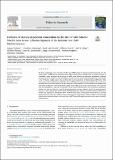Por favor, use este identificador para citar o enlazar a este item:
http://hdl.handle.net/10261/325928COMPARTIR / EXPORTAR:
 SHARE SHARE
 CORE
BASE CORE
BASE
|
|
| Visualizar otros formatos: MARC | Dublin Core | RDF | ORE | MODS | METS | DIDL | DATACITE | |

| Título: | Evidence of density-dependent cannibalism in the diet of wild Atlantic bluefin tuna larvae (Thunnus thynnus) of the Balearic Sea (NWMediterranean). |
Autor: | Uriarte-Ramalho, Amaya; Johnstone, Carolina CSIC ORCID; Laiz-Carrión, Raúl; García-Alcázar, Alicia; Llopiz, J.K.; Shiroza, Akihiro; Quintanilla-Hervás, José María; Lozano-Peral, Diego; Reglero, Patricia CSIC ORCID; Alemany, Francisco | Palabras clave: | Centro Oceanográfico de Málaga Pesquerías Atlantic Bluefin tuna larvae Stomach content analysis Piscivory-cannibalism Barcoding Microplastic debris |
Fecha de publicación: | 2019 | Editor: | Elsevier BV | Resumen: | The heavy exploitation rates of Atlantic bluefin tuna (ABFT) during the nineties propitiated research into the larval ecology of ABFT and its associated species. The transition from a planktivorous to a piscivorous diet is considered a major bottleneck in the survival of ABFT larvae observed in aquaculture experiments. Although larval piscivory was reported in the Gulf of Mexico (GOM), the most important spawning grounds of this species in the W Atlantic, trophic studies have not been able to reveal piscivory in Mediterranean ABFT larvae. This study analyzes the trophic behavior of Mediterranean ABFT larvae by stomach content analysis. The results show that more than 90% of the larvae had at least one prey in their stomachs. The diet shifted from copepods and cladocerans to gastropod larvae in pre-flexion stages and to ABFT larvae in post-flexion stages. This is the first time that cannibalism is reported for wild ABFT larvae from the Mediterranean Sea. Intracohort cannibalistic feeding was observed when the requisite density-dependent processes aligned, namely the spatio/temporal overlap of a wide range of ABFT larval cohorts of different size class. Moreover, stomach contents of ABFT larvae revealed the ingestion of microplastic fibres. Whether these plastic contaminants were passively or actively ingested, they may affect the condition of larvae. The presence of microplastic strands in fish larvae undoubtedly raises concern because its impact on the survival of ABFT larvae still remains uncertain and is open to scientific experimentation. | Versión del editor: | https://www.sciencedirect.com/science/article/pii/S0165783618303588 | URI: | http://hdl.handle.net/10261/325928 | DOI: | 10.1016/j.fishres.2018.12.013 | ISSN: | 0165-7836 |
| Aparece en las colecciones: | (IEO) Artículos |
Ficheros en este ítem:
| Fichero | Descripción | Tamaño | Formato | |
|---|---|---|---|---|
| Evidence of density-dependent cannibali...iterranean) _ Elsevier Enhanced Reader.pdf | 6,32 MB | Adobe PDF |  Visualizar/Abrir |
CORE Recommender
SCOPUSTM
Citations
20
checked on 22-abr-2024
WEB OF SCIENCETM
Citations
19
checked on 27-feb-2024
Page view(s)
23
checked on 15-may-2024
Download(s)
17
checked on 15-may-2024
Google ScholarTM
Check
Altmetric
Altmetric
Este item está licenciado bajo una Licencia Creative Commons

